Business
Musk’s New Twitter Rebrand X: Good or Bad for Business?
Published
2 years agoon
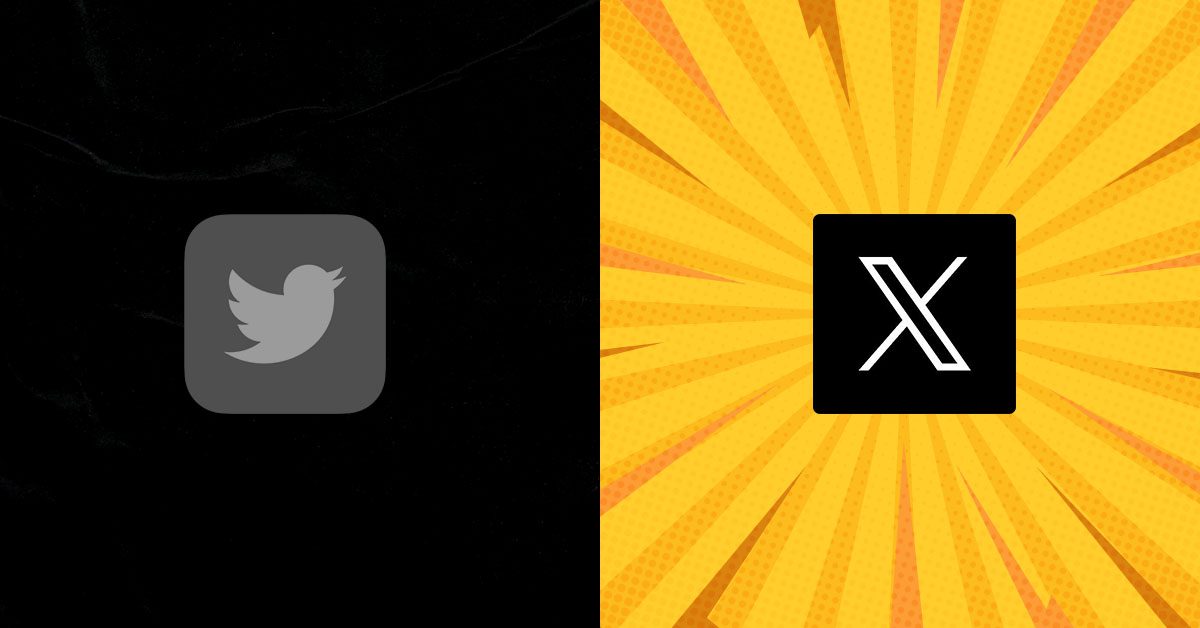
They said it wouldn’t happen, but here we are: Elon Musk has killed Twitter. Well, rebranded it.
Twitter is now simply X, and people both on and off the popular social platform are going, “Huh?” We’ll explore what the new branding means, how likely it is to stick, and what the reasoning behind it might be.
What happened to Twitter?
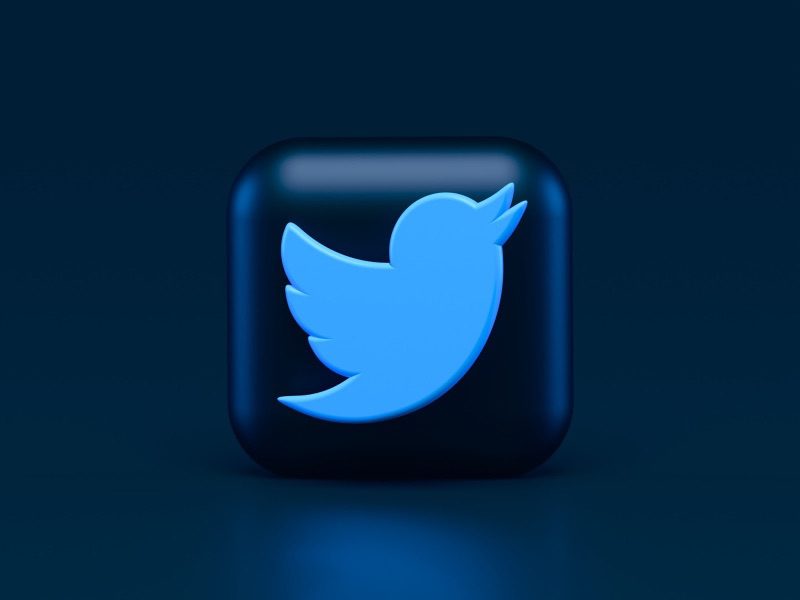
If you logged onto Twitter for the first time in a bit this week, you may have been hit with a shock. That iconic blue bird in the upper left has been replaced by a simple unicode character: 𝕏.
The announcement came suddenly, late at night on July 24th: Twitter was no more. The social network would now be called “X,” and gradually, all Twitter branding would be dropped, courtesy of executive chair Elon Musk.
Changing that upper right logo on Twitter for Desktop was easy—earlier this year, Musk replaced it with a doge meme. After that, Musk made x.com redirect to Twitter and changed all company profiles from “Twitter” to “X.” They actually had to buy the Twitter handle @X, which had been taken since 2007.
Is Twitter gone?
So far, a lot of X is still Twitter. The app is still Twitter, the URL is still twitter.com, and the old blue bird is still easy to find. Funny enough, if you open X without a login, you’ll see the X logo above an invitation to “Join Twitter today.”
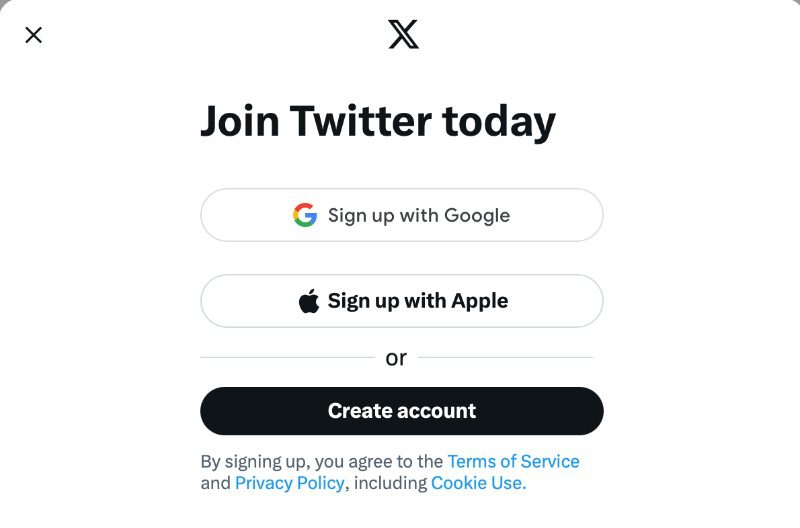
If this rebrand continues apace, it could be a few months before the Twitter branding is fully dropped. For some, the new name represents a new beginning. But some legacy users may take this as a sign that Twitter as they knew it is dead.
Why did Twitter rebrand?

According to X CEO Linda Yaccarino, the company hopes to move away from social networking and towards a much broader range of digital services. They want to turn Twitter into a space for media, marketing, messaging, banking, and more, all powered by AI.
How has Twitter branding changed over time?
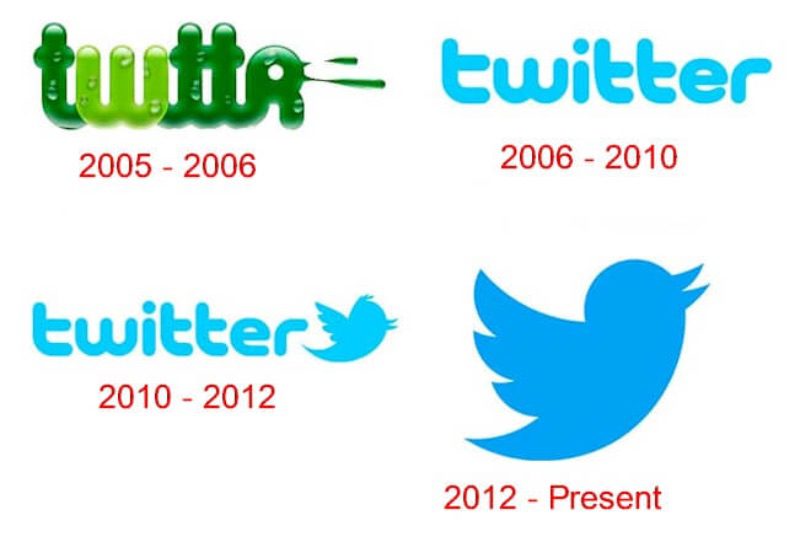
Up until now, Twitter has had some of the most consistent branding in all of social media. By the time it went public in 2006, it already had the light blue bird branding—and a lot of the same UI design we associate with it today.
In 2012, Twitter underwent their biggest rebrand. They dropped their wordmark and introduced a sleeker, more iconic version of their blue bird logo. Since then, Twitter branding went essentially unchanged for 11 years.
To put that into perspective, Twitter is essentially the only social network to keep its branding from the early ‘10s. Facebook, Instagram, and Pinterest have all rebranded since then; Foursquare and Google+, two of the era’s other heavy hitters, have gone under.
Through that lens, it might make sense for Musk, Yaccarino, and the rest of the Twitter team to feel that a refresh was necessary. On the other hand, Musk’s own history indicates something a little more personal.
Elon Musk’s history with the letter X
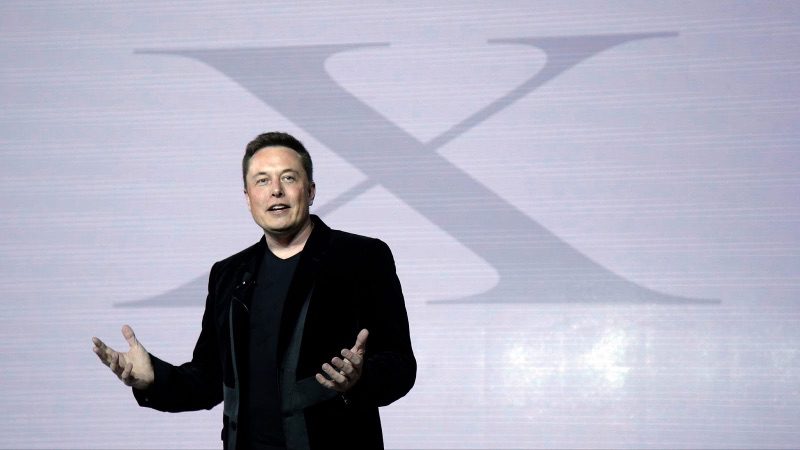
Let’s take it back to October 2022, before Twitter got bought out by Musk and back when it was, if nothing else, fairly reliable.
Musk was weeks away from closing the deal, after unsuccessfully trying to pull out of it. After much secrecy, he finally offered a cryptic insight into why he chose to buy the social network:
Buying Twitter is an accelerant to creating X, the everything app
— Elon Musk (@elonmusk) October 4, 2022
Let’s back it up even further, actually.
1999: Musk co-founds X.com

One of the most talked-about promises for the new Twitter is a banking hub. But that idea goes all the way back to the original x.com, an online bank founded by Musk in 1999.
The bank merged with its biggest competitor, Confinity, in 2000. Later that year, the board voted to replace Musk as CEO with Confinity co-founder Peter Thiel, while Musk was away on his honeymoon.
The next year, the company was renamed PayPal.
2002: SpaceX takes flight
Musk’s next endeavor was a space development project with the goal to reduce the costs of space travel and eventually colonize Mars. Its full name is the Space Exploration Technologies Corporation, but it’s commonly referred to as Space… X.
2017: Musk buys back X.com
Two years after releasing his Tesla Model X, Elon bought back the X.com domain from PayPal, citing its “great sentimental value.” As of this week, it now redirects to Twitter.
2020: Musk names his child X
Musk has had 10 kids with 4 partners, but the most notorious is his bizarre romance with indie pop star Grimes. Their child, born in 2020, is infamously named X Æ A-12, but referred to by both parents as X.
2023: Twitter, Inc. becomes X Corp.
Months prior to rebranding Twitter as X, Musk brought the social network under a new business, X Corp., announcing that the Twitter company “no longer exists.”
Is the Twitter rebrand good or bad?

That’s a matter of personal opinion, but there’s certainly plenty of reasons to be skeptical. Here’s some pros and cons:
Pros of the Twitter rebrand
A fresh start: Clearly, Musk’s plan for Twitter for at least the past year has been to use it as a launchpad for his “everything app.” If the plan is to roll out new, useful tech to Twitter’s large user base, it could turn out positive in the long run.
Twitter’s baggage: Like most of Silicon Valley, Twitter’s rep has soured in the past decade. Even before Musk took over, it became synonymous with toxic discourse, fake news, and harassment. While Musk’s constant changes didn’t help matters, they’re another reason why a brand refresh might be necessary. Facebook doesn’t want to be Facebook anymore, why should Twitter want to be Twitter?
Thinking bigger: When Tucker Carlson took to Twitter, he quickly fell off the map. The fact is, people don’t see Twitter as a place for long-form video. Musk clearly hopes to change that, and maybe abandoning Twitter’s rep for 280-character microblogging is the way to do it.
Cons of the Twitter rebrand
Twitter’s old branding is iconic: Twitter never had the biggest user base, but its cultural cache was undeniable. After making Twitter more toxic—and more annoying—many would argue that the only value it had left was its brand name. Musk’s $44 billion investment was already bleeding cash, and now it’s shed its tremendous brand recognition on purpose?
Pushing users away: A rebrand can be a fresh start for a brand when it’s accompanied by new offerings, but all this one does is encourage legacy users to jump ship. Twitter’s dead, now you’re hanging around on Elon’s pet project. That’ll be eight dollars.
Poor concept: We’re getting into opinions here, but let’s be real. Remember when U2 put their album on everyone’s phone? Now, Elon is foisting his “everything app” on Twitter’s user base. No one asked for it, it’s a 12-year-old’s idea of a cool app, and if it goes as smoothly as the other recent changes at Twitter, it’s dead on arrival.
Why do companies rebrand?
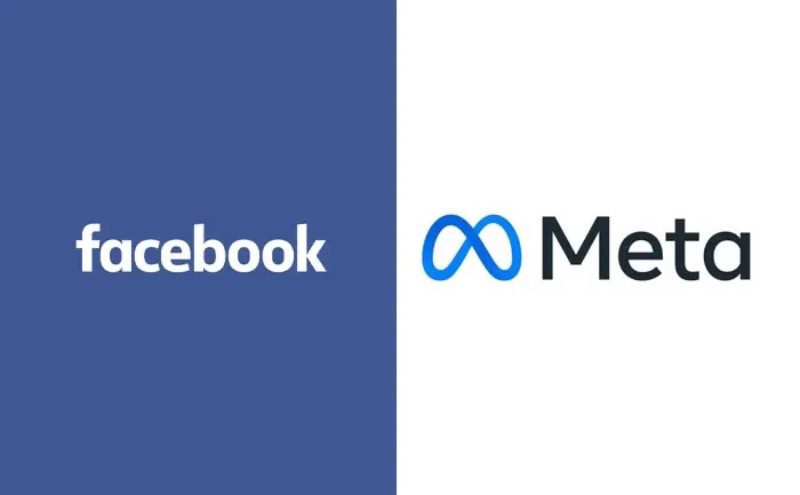
Branding is an important element of any company. Whether you use an in-house team or outside help, keeping your brand consistent across channels is key to business growth.
At Owners Mag, we rely on Penji, a subscription-based graphic design service, to keep our branding fresh.
Growing companies often rebrand when they plan to reach a broader audience or expand their offerings. As they scale, they may be able to afford higher-end branding, or have a greater need for brand consistency.
When a major company like Facebook or Twitter rebrands, it’s a dangerous game. Customers know these brands well, and they often react negatively to changes—even minor ones. So, why do they do it?
- Shifting focus: If a brand wants to change its identity, changing their visuals can help. This can reflect new values, new services, or changes in company structure. It’s the stated reason for the Twitter rebrand; they want to move away from microblogging and towards an “everything app.”
- Reputation control: This is another potential reason for Twitter’s rebrand. When a company develops an extremely negative reputation, it may change its name and branding to help lighten it. In 2003, infamous tobacco company Philip Morris rebranded as Altria.
- Modernizing: Ever notice how logos have gotten flatter and simpler over time? Consumer brands will make more subtle changes to their logo & branding to reflect changing aesthetics of the time. Many companies changed their branding in the mid-’10s to be more legible in different screen formats.
- Growing (or shrinking): Expanded to a new market? Dropped a major product line? Got bought out by another company? Any fundamental changes are often seen as a chance to rebrand, even if you’re not changing your values.
- Change for change’s sake: Not the most satisfying answer, but it’s true: companies often change their branding for no particular reason. Put yourself in the shoes of a new executive at a major brand. It’s had the same logo for decades now. Wouldn’t you be tempted to try something new?
From what we know, the Twitter rebrand seems to be a deliberate and planned choice. It reflects the platform’s desire to be much more than a space for short text posts.
The problem is, they haven’t introduced many of these promised features yet. For free users, Twitter doesn’t offer anything it didn’t offer a year ago; it just has a dull, forgettable new logo.
You may like
Business
Top 10 Best Places to Buy a Mid Century Modern Office Chair
Published
2 days agoon
July 4, 2025
What was once old is new again: mid century modern is back in style. From architecture to furniture, the postwar look is in, and the hype extends all the way to office chairs.
Do you need a mid century modern office chair in your life? If so, there’s plenty to choose from. Your office chair should be tailored to your style, whether you like luxury, utility, or something in between.
That’s why we’ve put together our 10 favorite places to find your ideal mid century modern office chair.
What is mid century modern design?
After World War II, spirits were high in the US, and new technology was taking the country by storm. Mid century modern refers to the design concepts that came about during this time.
As opposed to the frilly, ornate designs of classical furnishings, mid century modern designs are angular, material, and functional. Wood is a common design element, especially teak. Mid century modern furniture may also have materials like glass, vinyl, and metal. Designs are simple and geometric, with bold accent colors to make them pop.
The mid century modern aesthetic never really went away, but it’s made a noted comeback in recent years. Some have chalked it up to Boomer and Gen X nostalgia, others point to mid-century-set shows like Mad Men and The Marvelous Mrs. Maisel.
Why should I buy a mid century modern office chair?
Mid century modern is the perfect fusion of style and utility. If you want to cultivate an office space that commands respect without being ostentatious, mid century modern is the style for you.
When it comes to office chairs, an MCM one is often made with sturdy wood and vinyl. They combine the ergonomics of a modern office chair with old-fashioned grace.
If you’re concerned with utility and utility only, a more bog-standard office chair may suit you. But a mid century modern office chair is great for someone who wants to wow colleagues with a mature, thoughtful business space.
Where can I get a mid century modern office chair?
1) Wayfair
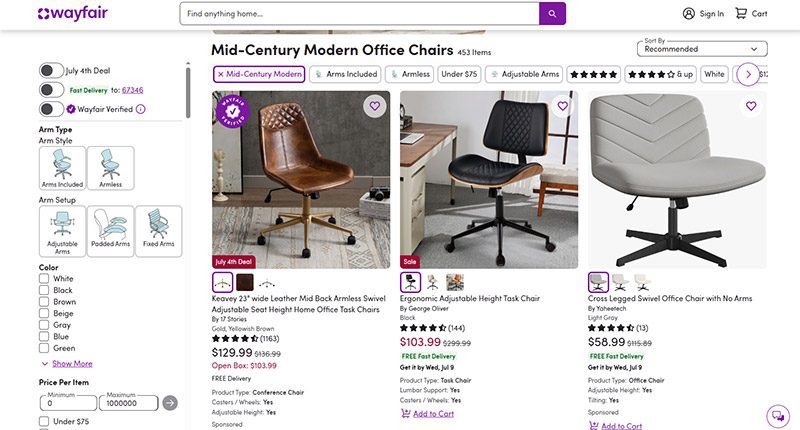
When it comes to furniture, Wayfair offers the best of both worlds. Their goods, including their mid century modern office chairs, are stylish and affordable. You can get a sturdy task chair for less than $100 or a more distinguished seat for less than $350.
MCM office chair examples: Dovray ($126), Bradford ($139), Lithonia ($133)
2) France & Son

Wayfair’s chairs are affordable, but France & Son is the perfect option for luxury shoppers. Their mid century modern office chairs are robust and sleekly designed. If you dress to impress and enjoy the finer things in life, these are the chairs for you.
MCM office chair example: Brooks ($695)
3) Houzz

Started as a community for people to share home decor tips, Houzz has become a great ecommerce platform for finding stylish furniture. They’re more known for home decor than desk chairs, but they have plenty of great, affordable finds if you know where to look.
MCM office chair examples: Arvilla ($173), Rathburn ($259)
4) Laura Davidson

The Laura Davidson collection offers a fairly limited selection of classic office furniture. Still, there’s a reason they’re trusted by big-wigs like Apple, Disney, and Salesforce. Their chairs are sturdy and beautifully designed, reimagining classic Eames and Knoll designs.
MCM office chair examples: Rockefeller ($275), SOHO II Soft Pad ($450)
5) Icons of Manhattan

Icons of Manhattan has a simple philosophy: do one thing, and do it right. Their office chairs are handcrafted from premium materials and tailored to a mid-century modern style. If you want that Mad Men energy in your office (hopefully with a lot less angst), these are the chairs for you.
MCM office chair example: Ribbed Medium ($219)
6) Amazon

Yes, the internet’s premier shopping destination has a robust collection of mid century modern office chairs. Like with most products, their selection of seats is vast and can be hit or miss. Still, they’ve got stunning chairs available for any style, whether you care about comfort, class, or ergonomics.
MCM office chair examples: IDS Home Modern ($219), Art Leon MCM Swivel ($139)
7) AllModern

AllModern’s collection of desk chairs and other furniture truly embodies the mid century modern spirit. Their work is tight, angular, and functional above all. They’re part of the Wayfair family and they traffic in a number of modern styles, but their sleek chairs are perfect for any mid century modern space.
MCM office chair examples: Frederick ($229), Kealey ($349)
8) Overstock
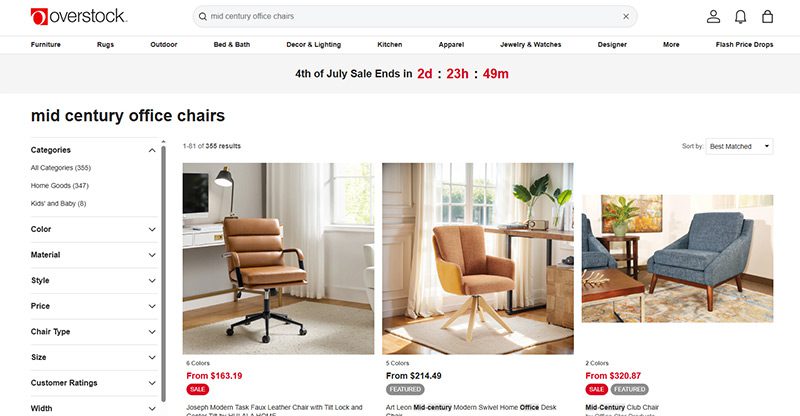
Overstock is known as a one-stop shop for quality home goods at sub-wholesale prices. If you want a spiffy mid century modern office chair that won’t break the bank, they’re the first place to look. While they’re somewhat less reliable than the more upscale platforms on this list, their selection is massive.
MCM office chair example: Joseph Modern ($163)
9) Walmart
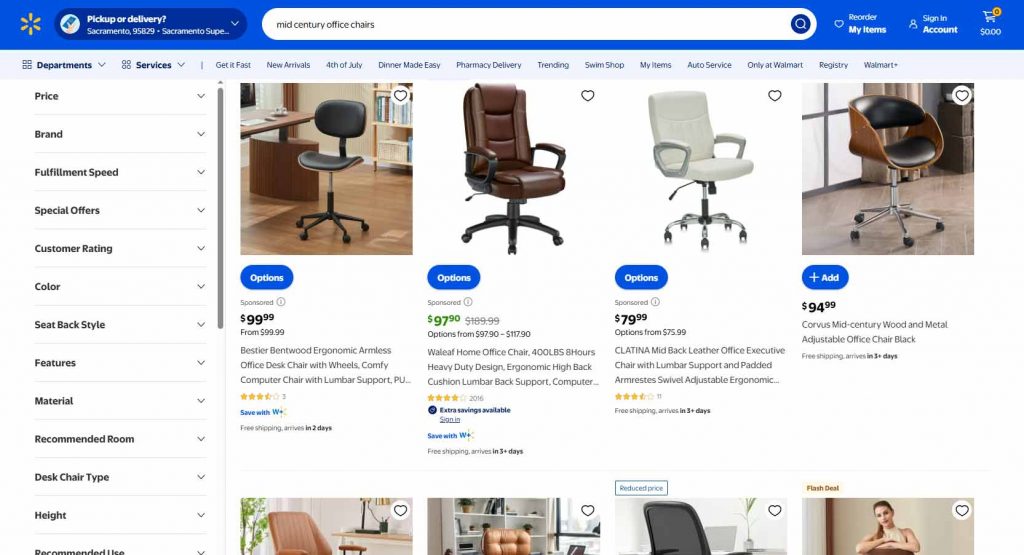
Hayneedle’s selection of mid-century modern office chairs falls somewhere between the minimal Laura Davidson and the endless Amazon catalog. Their array of mid-century designs is affordable and versatile, with chairs that match almost any style. While they may be part of the Walmart family, these chairs are anything but second-rate.
MCM office chair example: Waleaf ($97)
10) Target
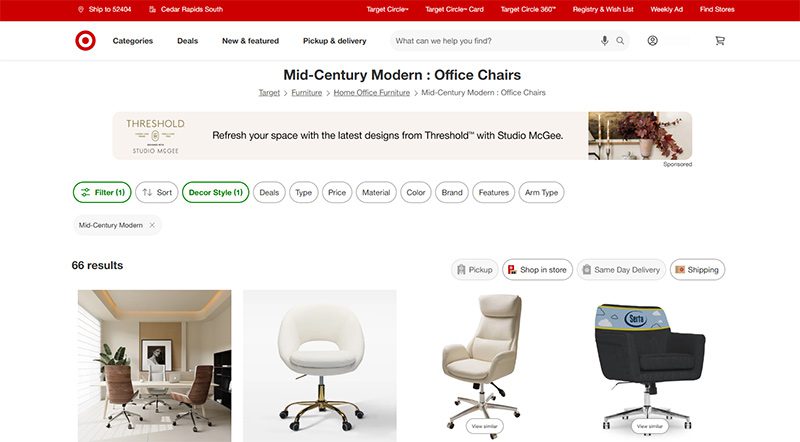
Why splurge when you can save? As usual, Target is a hidden gem, offering a sturdy selection of mid century modern office chairs for some of the cheapest prices out there. Many of the chairs they offer are from the same designers as these other stores—Christopher Knight, LumiSource, Armen Living, etc.—at reduced prices.
MCM office chair example: Lombardi ($136)

A quality payroll service is one of the most invaluable tools any entrepreneur can have. Whether you’re a small business owner or an HR manager, paying your employees on time is crucial. This makes choosing a service even more weighty, after all, it is a heavy administrative burden. The good thing is, you can outsource this duty to an online payroll processor.
According to statistics, 49% of workers begin a new job search after just two paycheck errors, and with 65% of workers living paycheck to paycheck, it’s more important than ever to ensure an efficient, effective payroll process.
These services can save you precious time and mitigate potential issues. To make it easy for you to choose, we listed the best online payroll services for 2025.
Top 5 Online Payroll Services
Gusto
Gusto is a great option for both new and experienced payroll administrators, boasting an incredibly clean user interface and a first-rate payroll setup. Gusto lets you manage your employee’s time off (vacation and sick pay), company health insurance, and worker’s comp. Gusto offers excellent mobile access, too. This allows employees to manage aspects of their Gusto profiles, view payday insights, and access Gusto Wallet financial tools.
Gusto offers four tiers of membership, the most affordable of which is the Contractor’s Only plan, which offers unlimited U.S.-based and global contractor payments, supporting more than 100 countries, plus 1099 creation and filing at a rate of $6 per person per month with no base price.
The other three are Simple, Plus, and Premium. Here’s a deeper look into each plan:
Simple
Price:
$40/mo + $6/mo per person
Plan details:
- Full-service single-state payroll including W-2s and 1099s
- Employee profiles and self-service
- Basic hiring and onboarding tools
- Gusto-brokered health insurance administration
- Employee financial benefits
- Payroll and time-off reports
- Custom admin permissions
- Integrations for accounting, time tracking, expense management, and more
Plus
Price:
$80/mo + $12/mo per person
Plan details:
(All Simple plan features +)
- Full-service multi-state payroll including W-2s and 1099s
- Next-day direct deposit
- Advanced hiring and onboarding tools
- PTO management and policies
- Time tracking and project tracking
- Workforce costing and custom reports
- Team management tools
- Full support
Premium
Price:
Bespoke pricing, reach out for a personalized quote
Plan details:
(All Plus plan features +)
- HR Resource Center
- Compliance alerts
- Access to certified HR experts
- Full-service payroll migration and account setup
- Health insurance broker integration
- R&D tax credit discount
- Waived fees and exclusive pricing
- Performance reviews
- Employee surveys and insights
- Dedicated support
QuickBooks Online Payroll
Founded in 1983, Intuit is a California-based financial software company. Since its inception, Intuit has developed into one of the best-known providers of accounting software. Their online payroll service, QuickBooks, includes the essential features you need to run payroll.
QuickBooks offers three tiers of membership. The least expensive membership covers basic accounting features, such as invoices. For more features, check out the Essentials and Plus memberships. Each plan’s features are as follows:
QuickBooks Simple Start (2025)
- Price: $38/month for 1 user
- Best for: Freelancers and small teams with basic payroll needs
Features:
- Automated bookkeeping
- 5 free ACH bank transfers/mo for bills
QuickBooks Essentials (2025)
- Price: $75/month for 3 users
- Best for: Small businesses needing deeper financial tracking
Features:
- Includes all Simple Start features, plus:
- Recurring invoices
QuickBooks Plus (2025)
- Price: $115/month for 5 users
- Best for: Growing businesses with HR and compliance needs
Features:
- Includes all Essentials features, plus:
- AI-powered profit & loss insights
- Anomaly detection and resolution
- Budgeting
QuickBooks Advanced (2025)
- Price: $275/month for 25 users
- Best for: Established businesses with HR and compliance needs
Features:
- Includes all Plus features, plus:
- Custom user management and permissions
- Custom report builder
- Data sync with Excel
- Revenue recognition
- Forecasting
OnPay

OnPay is a cloud-based full-service payroll processing system capable of running payroll according to a preset schedule, automatically disbursing wages, and calculating and withholding taxes.
OnPay can sync up with several other software your team is already using, making it easy to integrate the service into your team’s system. Another benefit of OnPays model is the simple, transparent pricing structure. No tiers; just one base rate.
Pricing:
$49/mo + $6/mo per employee
SurePayroll

SurePayroll’s award-winning service supports W-2 employees and 1099 contractors. Additionally, it handles 401(k) deductions and manages flexible spending accounts (FSA) and health savings accounts (HSA).
SurePayroll also offers a mobile app— available on both Apple and Android devices.
SurePayroll offers live support through its United States-based support team through chat, email, or phone.
Small Business Payroll
- Price: No Tax Filing: $20/month + $4 per employee, Full Service: $29/month + $7 per employee
- Best for: Small businesses and startups
Features:
- We file and deposit your federal and state taxes!
- Run payroll in 3 simple steps
- Schedule payroll to run automatically
- Unlimited payroll runs and free 2-day direct deposit
- Reports and pay stubs are available online 24/7
- Supports W-2 employees and 1099 contractors
Nanny & Household Payroll
- Price: Full-Service Household, $39/month, includes 1 employee, $10 per additional employee
Best for: Homeowners
Features:
- Signature-ready Schedule H
- We file & deposit your federal and state taxes!
- Run payroll in 3 simple steps
- Schedule payroll to run automatically
- Unlimited payroll runs and free 2-day direct deposit
- Reports & paystubs available online 24/7
- Supports W-2 employees & 1099 contractors
Be sure to choose a payroll service that works for your business, and provides you with the peace of mind that comes with a reliable bookkeeping system. Your employees will thank you.

Merck is currently in talks to acquire Seagen, a biotech company. The Wall Street Journal reports that the transaction is valued at $40 billion. And what happens if Merck acquires Seagen, and how would this acquisition benefit cancer research and treatment? Read more about the Merck Seagen buyout here.
Merck Seagen Buyout
Merck and Seagen are still deciding on their share prices. So far, talks have yet to reach an agreement on $200 per share. Both companies want to settle and finalize their deals before Merck announces its quarterly earnings on July 28. At the time of writing, Seagen’s stock was at $176.19.
With an estimated market value of $235 billion, Merck is looking to expand its presence in the cancer treatment space. The Merck Seagen Buyout could play a major role in that strategy. Since Seagen specializes in targeted cancer therapies, the acquisition would give Merck access to a broader range of oncology products.
Shareholder reactions to the new deal are overwhelmingly positive, and the stocks have been up since talks about the deal have been made public.
But this is not the first time that Merck and Seagen have made the news. Back in 2020, they collaborated because of cancer treatments. Seagen has a drug conjugate (ladiratuzumab vedotin) which would be used in conjunction with Merck’s Keytruda.
Merck reveals that Keytruda is its highest-selling product. It’s immunotherapy for cancer.
And this deal could help Merck offset the possibility of reduced sales because it will lose patent protection in 2028.
As promising as this deal is, there could be scrutiny from antitrust officials since there might be a litigation case from the Federal Trade Commission or Justice Department.
The Seagen buyout isn’t the only deal Merck has made recently. They’ve been busy closing another deal, but with Orion too.
Seagen
As a cancer biotech company, Seagen has therapies to ensure that patients benefit from the treatment and reduce any adverse side effects. Their treatments involve the therapy attacking tumors with toxins.
Merck partnering with Seagen isn’t a bad idea considering that Seagen made $1.4 billion in sales in 2021, most of it coming from Adcetris and Padcev (a treatment for urothelial cancers).
Merck-Orion Deal
In the middle of the Merck Seagen Buyout, Merck has recently partnered with Orion for the ODM-208 and other drugs. These drugs are related to the production of steroids. Orion found how it can combat hormone-dependent cancers and further developed this inhibitor.
Their deal includes that they should develop ODM-208 and promote it to the public together. And Orion will receive a $290 million payment from Merck.
Although they’re co-developing and marketing the new inhibitor, Orion will oversee the manufacturing side.
Co-developing the ODM-208 can help Merck with its current research and treatments for prostate cancer. President and CEO of Orion, Timo Lappalainen, says that this partnership will benefit Merck’s goals of treating cancer worldwide.
Other Ventures: Merck’s Role in the Pandemic
You may have heard about COVID-19 pills, which are a form of treatment for those diagnosed with mild to moderate COVID-19. Merck introduced an antiviral COVID-19 pill to the public. The name: Molnupiravir.
The COVID-19 pill is not a replacement for a vaccination. Instead, it stops the replication of the COVID-19 genetic code and keeps the patient out of the hospital. Not yet FDA-approved, Molnupiravir has been authorized for emergency use since December 23, 2021.
And for other stories, read more here at Owner’s Mag!

Top 12 Uses for The Metaverse That Will Change Your Life

Top 10 Best Places to Buy a Mid Century Modern Office Chair

The Best Online Payroll Services [Updated for 2025]

Top 10 Small Business Organization Tools for 2025

8 Best Equipment for YouTube Every Content Creator Needs

Merck Seagen Buyout: What to Know About the Deal

The Rise and Fall of Juul: Once a Silicon Valley Darling, Now Banned by FDA

What’s the Deal With Elomir? Is Axis Klarity a Scam?

Why Having an Advisory Board Could Make or Break Your Startup

Top 10 Best Places to Buy a Mid Century Modern Office Chair

Loom Review: Features, Use Cases, and How It Stacks Up Against Zoom

8 Best Equipment for YouTube Every Content Creator Needs

The Rise and Fall of Juul: Once a Silicon Valley Darling, Now Banned by FDA

The Best Ways to Recession Proof Your Business
Trending
- Business2 days ago
Top 10 Best Places to Buy a Mid Century Modern Office Chair
- Technology4 days ago
8 Best Equipment for YouTube Every Content Creator Needs
- Technology3 days ago
Top 10 Small Business Organization Tools for 2025
- Technology1 day ago
Top 12 Uses for The Metaverse That Will Change Your Life
- Business2 days ago
The Best Online Payroll Services [Updated for 2025]





